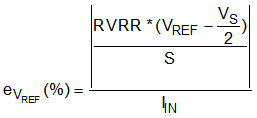ZHCSK83B September 2019 – July 2021 TMCS1100
PRODUCTION DATA
- 1 特性
- 2 应用
- 3 说明
- 4 Revision History
- 5 Device Comparison
- 6 Pin Configuration and Functions
- 7 Specifications
- 8 Parameter Measurement Information
- 9 Detailed Description
- 10Application and Implementation
- 11Power Supply Recommendations
- 12Layout
- 13Device and Documentation Support
- 14Mechanical, Packaging, and Orderable Information
10.1.1.2 Full Temperature Range Error Calculations
To calculate total error across any specific
temperature range, Equation 26
and Equation 27
should be used for RSS maximum total errors, similar to the example
for room temperatures. Conditions from the example in Section 10.1.1.1 have been replaced with their respective equations
and error components for a
–40°C to
85°C temperature range below in Table 10-2.
Table 10-2 Total Error Calculation: –40°C to 85°C Example
| ERROR COMPONENT | SYMBOL | EQUATION | % MAX TOTAL ERROR AT IIN = 25 A | % MAX TOTAL ERROR AT IIN = 12.5 A |
|---|---|---|---|---|
| Input offset error | eIos,ΔT |  | 0.28% | 0.56% |
| PSRR error | ePSRR |  | 0.27% | 0.54% |
| CMRR error | eCMRR |

|
0.01% | 0.02% |
| VREF error | eVREF |  | 0.04% | 0.08% |
| External Field error | eBext |  | 0.11% | 0.22% |
| Sensitivity error | eS,ΔT | Specified in Section 7.9 | 0.85% | 0.85% |
| Nonlinearity error | eNL | Specified in Section 7.9 | 0.05% | 0.05% |
| RSS total error | eRSS,ΔT |  | 1.03% | 1.43% |